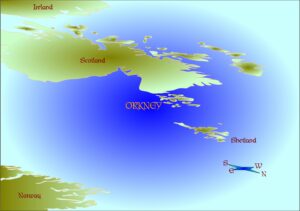
When I studied archaeology many moons ago we were taught (to paraphrase), very much along the lines that civilization had come out of the east. It was a time of diffusionist ideas and thus it naturally flowed that new developments would appear first somewhere around the Straits of Dover and gradually work their way north. Text books, like Lacaille’s excellent ‘The Stone Age in Scotland’, followed this model, fitting the available evidence into a paradigm whereby early-looking stone tools in the north of Scotland were interpreted as representing archaic Mesolithic survivals, still in use in a backward northern society, centuries after people further south had taken advantage of more recent developments.
I can’t remember when I first became aware of the idea of perceptual geography, but I do remember being very taken with a map of the North Sea which I first saw in Bergen in the mid 1980s. I still have a copy on my wall. It looked west, from Bergen across to Scotland, and I suddenly realised that the world could operate very differently for those who do not need tarmac roads and governmental regulation from Westminster (or Edinburgh). It was an idea that I have tried to develop ever since. Thus, when people asked why a remote site like Rum was settled so early on, I could discuss the needs of the Mesolithic population and point out that, for a mobile, sea-going people, islands like Rum are in similar locations to the motorway service stations of England. Equally, if you skew the map of the North Sea, then the central position of Orkney in the maritime empire of the Norsemen becomes obvious.
As my research continued, it became clear that the earliest settlement of Scotland after the Ice Age was not a simple matter of people making their way slowly north as conditions improved. Rather, it looked as if there may have been several ‘homelands’ including perhaps somewhere in the vicinity of southern Scandinavia where the stone tools shared certain characteristics with those of northern Scotland. Today, we might recognise this as affirmation of the migration of groups along the northern coastlands of Doggerland.
In recent years this has been followed by discussion of the primacy of societal and cultural developments in Neolithic Britain and the suggestion that elements such as Grooved Ware may have been part of a migration of ideas from north to south (an argument eloquently set out by Julian Thomas in his 2010 paper: The Return of the Rinyo Clacton Folk). Following this line of reasoning, iconic monuments such as Stonehenge become the culmination of seeds that first sprouted in the fertile fields of Neolithic Orkney and around monuments such as the Stones of Stenness.
I’m sure there are other examples in the intervening millennia but if we fast forward to today, it is interesting to note the extent to which things ‘northern’ have now become popular. We have Nordic food and design, Scandi-noir in publishing and on television, new histories of northern exploration, and a host of books exploring our attitude to the north. For the first time for ages, living in the north is no longer the symbol of the recluse but rather it is the trendy thing to do. At the same time our politics is fragmenting. Northern communities demand a voice and the developing primacy for everyday society of internet technology over the internal combustion engine is allowing them to develop it.
We no longer need to be able to reach London in a day. Those of us who live in the north, are happy in the north, and those who don’t, seem, increasingly, to wish they did. But then, as archaeologists, we knew this all along.
You must be logged in to post a comment.